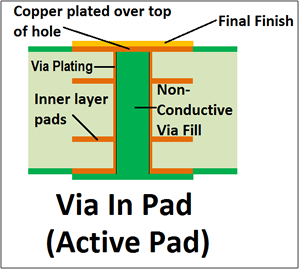Vias Plated Shut with Copper
 This is an older callout sometimes seen on legacy products. The original idea was to call for this as a way to have a copper conductive filled via. The problem with this process is that the holes must be extremely small to make this feasible since the copper used to to plate a via closed will also plate on all copper features on the board. (All vias and surface copper). Since 1oz of copper = 1.4mils, the amount of plating required to plate closed an 8 mil drilled hole is 2.8oz. 8mil/2 = 4 since plating is applied to both “sides” of the hole barrel. 4mil/1.4 = 2.85oz. This is 2.85oz additional copper to what is already on the surface of the board. This would bring the design’s total copper weight to 3.5 to 4oz. Tight space and trace designs are not possible with this amount of copper.
This is an older callout sometimes seen on legacy products. The original idea was to call for this as a way to have a copper conductive filled via. The problem with this process is that the holes must be extremely small to make this feasible since the copper used to to plate a via closed will also plate on all copper features on the board. (All vias and surface copper). Since 1oz of copper = 1.4mils, the amount of plating required to plate closed an 8 mil drilled hole is 2.8oz. 8mil/2 = 4 since plating is applied to both “sides” of the hole barrel. 4mil/1.4 = 2.85oz. This is 2.85oz additional copper to what is already on the surface of the board. This would bring the design’s total copper weight to 3.5 to 4oz. Tight space and trace designs are not possible with this amount of copper.Another drawback is the extreme difficulty in plating the entire barrel of the hole evenly. A hole barrel will tend to plate faster toward the top and bottom of the hole which means a hole may look sealed but in the center there is trapped air and/or fluids which will outgas when exposed to assembly temperatures. We will not attempt this type of fill since far more reliable alternatives exist.
Baggio WANG FAN
-----------------------------------------------------------
SHENZHEN JAAPSON TECHNOLOGY CO LTD
Building 2, Tongfuyu Industrial Park,Shenzhen, China, 518104
Tel: 86-755-82596922
Fax:86-755-82596922/82596923
skype: baggiowang0214
baggio.wang@funsunpcb.com
baggio@jaapson-pcb.com
www.jaapsonpcb.com
JAAPSON, The Expert in HDI Multi-layer PCBs
 You now have a solderable surface mount pad that also passes signal to inner layers eliminating the need to rout the signal to a via on the surface layer.
You now have a solderable surface mount pad that also passes signal to inner layers eliminating the need to rout the signal to a via on the surface layer.






